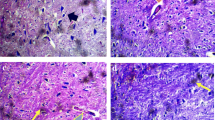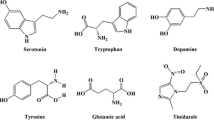Abstract
In this study, we investigated the protective effect of total glycosides of paeony against Semen Strychni-induced neurotoxicity and discussed some probably mechanisms. Levels of estrone, estradiol, estriol and growth hormone in male rats’ serum were determined by ELISA, levels of ATP and substances associated with energy metabolism in rats’ brain were determined by HPLC and levels of progesterone was determined by a UPLC-MS/MS method. The results showed that neurotoxicity induced by Semen Strychni could cause a significant decrease (p < 0.05, compare to the blank group) in secretion of estrogens and GH and disorder brain energy metabolism at the same time. While, rats with total glycosides of paeony pre-protection (orally administrated with total glycosides of paeony for 15 days before administrating Semen Strychni extract) showed a much better condition in the secretion of hormones and brain energy metabolism, and showed no significant changes in most of those associated substances when comparing to the blank group. Our study indicated that total glycosides of paeony have neuroprotective effects on Semen Strychni-induced neurotoxicity. It could recover the disordered hormone secretion and improve the brain energy metabolism. Total glycosides of paeony is potential to be further used in clinic to protect against neurotoxicity induced by other reasons.






Similar content being viewed by others
Abbreviations
- TBI:
-
traumatic brain injury
- SAH:
-
subarachnoid hemorrhage
- HIE:
-
hypoxic ischemic encephalopathy
- GHD:
-
Growth Hormone Deficiency
- ELISA:
-
Enzyme Linked Immunosorbent Assay
- HPLC:
-
High Performance Liquid Chromatography
- UPLC-MS/MS:
-
Ultra-performance Liquid Chromatography Tandem Mass-spectrometry
- P4:
-
progesterone
- MPA:
-
medroxyprogesterone acetate
- E1:
-
estrone
- E2:
-
estradiol
- E3:
-
estriol
- GH:
-
growth hormone
- ATP:
-
adenosine triphosphate
- ADP:
-
adenosine diphosphate
- AMP:
-
adenosine monophosphate
- E.C.:
-
Energy Charge
- TGP:
-
total glycosides of paeony
References
Arce VM, Devesa P, Devesa J (2013) Role of growth hormone (GH) in the treatment on neural diseases: from neuroprotection to neural repair. Neurosci Res 76:179–186
Chang BG, Zhi DS, Zhang S (2004) The Neuroprotective effects of estrogens in traumatic brain injury. Chinese Journal of Contemporary Nervous Diseases 4:177–179
Chapple LS, Deane AM, Heyland DK, Lange K, Kranz AJ, Williams LT, Chapman MJ (2016) Energy and protein deficits throughout hospitalization in patients admitted with a traumatic brain injury. Clinical nutrition 35:1–8
Chi QQ, Zhang H, Zhang XN, Wang XY, Sun XT (2010) Changes in Hypophyseal hormone after traumatic brain injury(TBI). Chinese Journal of Rehabil Theory and Practice 16:944–946
Cipriani S, Bakshi R, Schwarzschild MA (2014) Protection by Inosine in a cellular model of Parkinson’s disease. Neuroscience 274:242–249
Dachir S, Shabashov D, Trembovler V, Alexandrovich AG, Benowitz LI, Shohami E (2014) Inosine improves functional recovery after experimental traumatic brain injury. Brain Res 1555:78–88
Devesa J, Reimunde P, Devesa P, Barberá M, Arce V (2013) Growth hormone (GH) and brain trauma. Horm Behav 63:331–344
Engler-Chiurazzi EB, Brown CM, Povroznik JM, Simpkins JW (2016) Estrogens as neuroprotectants: estrogenic actions in the context of cognitive aging and brain injury. Prog Neurobiol 1420:1–24
Fernandes RMT, Gomes GC, Porcari AM, Pimentel JRV, Porciúncula PM, Martins-Júnior HA, Miguez PHP, da Costa JL, Amaral PH, Perecin F, Meurer EC, Furtado PV, Simas RC, Eberlin MN, Ferreira CR, Madureira EH (2011) LC-MS/MS quantitation of plasma progesterone in cattle. Theriogenology 76:1266–1274
Gu LQ, Bi KS, Chen XH (2014a) Determination of 12 potential nephrotoxicity biomarkers in rat serum and urine by liquid chromatography with mass spectrometry and its application to renal failure induced by Semen Strychni. J Sep Sci 37:1058–1066
Gu LQ, Wang XF, Liu ZZ, Bi KS, Chen XH (2014b) A study of semen Strychni-induced renal injury and herb–herbinteraction of radix Glycyrrhizae extract and/or Rhizoma Ligustici extract on the comparative toxicokinetics of strychnine and brucine in rats. Food Chem Toxicol 68:226–233
Hasko G, Sitkovsky MV, Szabo C (2004) Immunomodulatory and neuroprotective effects of inosine. Trends Pharmacol Sci 25:152–157
Huo TG, Chang B, Yang HL, Li WK, Zhang YH, Jiang H (2012) The effect of arsenic in realgar on brain energy metabolism in rats. Journal of Chinese Medicinal Materials 35:278–280
Jayaraman A, Pike CJ (2014) Differential effects of synthetic progestagens on neuron survival and estrogen neuroprotection in cultured neurons. Mol Cell Endocrinol 384:52–60
Jia XX, Li W, Li JS, Cai BC (2009) Progressive studies on toxicity of Strychons nuxvomica. China Journal of Chinese Materia Medica 34:2397–2399
Jovanovic V, Pekic S, Stojanovic M, Tasic G, Djurovic B, Soldatovic I, Doknic M, Miljic D, Djurovic M, Stojanoska MM, Popovic V (2010) Neuroendocrine dysfunction in patients recoveringfrom subarachnoid hemorrhage. Hormones 9:235–244
Kaminsky Y, Kosenko E (2009) Brain purine metabolism and xanthine dehydrogenase/oxidase conversion in hyperammonemia are under control of NMDA receptors and nitric oxide. Brain Res 1294:193–201
Khaksari M, Hajializadeh Z, Shahrokhi N, Esmaeili-Mahani S (2015) Changes in the gene expression of estrogen receptors involved in the protective effect of estrogen in rat's trumatic brain injury. Brain Res 1618:1–8
Li H, Yan ZY, Zhu J, Yang J, He JS (2011) Neuroprotective effects of resveratrol on ischemic injury mediated by improving brain energy metabolism and alleviating oxidative stress in rats. Neuropharmacology 60:252–258
Li R, Cui J, Shen Y (2014) Brain sex matters: estrogen in cognition and Alzheimer’s disease. Mol Cell Endocrinol 389:13–21
Liang LP, Zhao L, Wang L, Fu LY (2008) Nursing Experience of Hyperbaric Oxygen Therapy for 96 Cases of Craniocerebral Injury. Journal of Navy Medicine 29:76–77
Lin MX, Zhang H, Xu T (2002) Toxicological research of Semen Strychni. Information of Traditional Chinese Herbs 19:25–26
Liu J, Jin DZ, Xiao L, Zhu XZ (2006) Paeoniflorin attenuates chronic cerebral hypoperfusion-induced learning dysfunction and brain damage in rats. Brain Resaerch 1089:162–170
Liu Y, Tang YX, Liang XD (2013) Changes of the concentration of the toxic ingredients of Semen Strychni. When decocting with Paeonia lactiflora Pall. And its HPLC assay. Li Shizhen Medicine and Material Medical Research 24:1762–1763
Mink R, Johnston J (2007) The effect of infusing hypoxanthine or xanthine on hypoxic–ischemic brain injury in rabbits. Brain Res 1147:256–264
Philippe G, Angenot L, Tits M, Frederich M (2004) About the toxicity of some Strychnos species and their alkaloids. Toxicon 44:405–416
Prieto R, Tavazzi B, Taya K, Barrios L, Amorini AM, Di Pietro V, Pascual JM, Marmarou A, Marmarou CR (2011) Brain energy depletion in a rodent model of diffuse traumatic brain injury is not prevented with administration of sodium lactate. Brain Res 1404:39–49
Song DG, Zhang S (2008) Growth hormone deficiency (GHD) induced by traumatic brain injury (TBI). Medical Journal of the Chinese People’s Armed Police Forces 19:358–360
Wu ZL, Liu F, Wang YZ, Jiao XY, Shi M, Zhao QB, Ju G, You SW (2008) Reduced cell death by inosine pretreatment after photochemically induced cerebral ischemia in adult rats. Prog Nat Sci 18:1513–1518
Wu YC, Li YH, Xie SN, Li X, Yu S, He SD (2011) High performance liquid chromatographic determination of adenosine phosphates in the mouse brain. Journal of Capital Medical University 32:534–537
Xiang J, Tang YP, Wu P, Gao JP, Cai DF (2010) Chinese medicine nao-shuan-tong attenuates cerebral ischemic injury by inhibiting apoptosis in a rat model of stroke. Journal of Ethnopharmacology 131(1):174–181
Xu MH (1989) Changes of Function of Hypothalamus-pituitary gland- target gland in acute craniocerebral injury.Chinese. Journal of Critical Care Medicine 9:22–25
Xu HM, Wang K, Xu T (2007) Changes and Significance of Growth Hormone in Peripheral Blood of Children with Hypoxic Ischemic Encephalopathy. Zhejiang Clinical Medical Journal.9:1373
Xu N, Ran JX, Yang ZC, Lou SZ (2009) Researches on the toxicity of Datura metel L. Journal of Inspection and Quarantine 19:62–65
Xu WG, Yin LM, Zhao Z, Zhong DQ, Wang WT (2014) Clinical significance and changes of neuroendocrine during the recovery of traumatic brain injury. International Journal of Neurology and Neurosurgery 41:115–117
Yang XW, Yao WJ, Shi HT, Liu HL, Li YF, Gao YB, Liu RH, Xu LP (2016) Paeoniflorin protects Schwann cells against high glucose induced oxidative injury by activating Nrf2/ARE pathway and inhibiting apoptosis. J Ethnopharmacol 185:361–369
Yao WB (2011) Biochemistry. People's Medical Publishing House, Beijing, China
Yu HT, Mai RK, Ye WH, Jiang XF, Song Y, Shi XJ (2013) Determination of Gonadotropin Releasing Hormone in Cerebrospinal Fluid after Traumatic Brain Injury. Chinese Journal of Practical Nervous Diseases 16:17–19
Zhang Q, Yang MF (2010) Significance and changes of hypothalamus- hypophysis-gonad axis function of traumatic brain injury. Shandong Medical Journal 50: 16–17
Zhang L (2014) Pharmacological effects of Paeonia lactiflora Pall. Chinese Journal of Clinic 6:25–26
Zhao GW, Wang Y, Li YC, Jiang ZL, Sun L, Xi X, He P, Wang GH, Xu SH, Ma DM, Ke KF (2014) The neuroprotective effect of modified “Shengyu” decoction is mediated through an anti-inflammatory mechanism in the rat after traumatic brain injury. J Ethnopharmacol 151:694–703
Acknowledgements
This research was funded by the National Natural Science Foundation of China No.81673577.
Author information
Authors and Affiliations
Corresponding author
Ethics declarations
Conflict of interest
The authors declare that there are no conflicts of interest.
Rights and permissions
About this article
Cite this article
Hou, C., Zhang, R., Zhang, K. et al. Total glycosides of Paeony shows Neuroprotective effects against Semen Strychni-induced neurotoxicity by recovering secretion of hormones and improving brain energy metabolism. Metab Brain Dis 32, 2033–2044 (2017). https://doi.org/10.1007/s11011-017-0082-5
Received:
Accepted:
Published:
Issue Date:
DOI: https://doi.org/10.1007/s11011-017-0082-5




